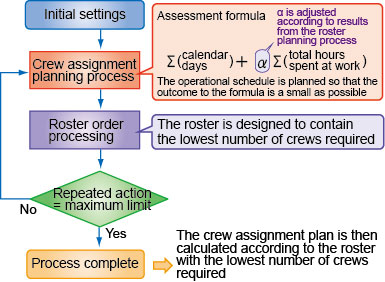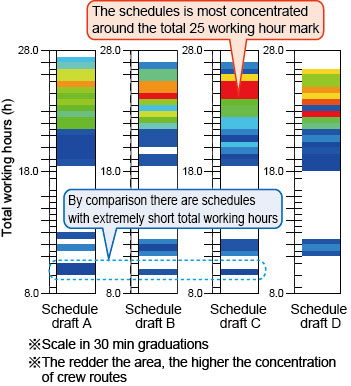3.Method for evaluating crew operational schedule and crew assignment planning taking roster order into account
- A method has been developed to allow more efficient crew assignment planning which takes into account rostering conditions such as average working hours and rest time at home.
- A visualization tool has been developed which makes it possible to evaluate and compare between operation schedule plans.
Conventional scheduling methods which aim to reduce the number of scheduled days as much as possible, do not allow for consideration of factors required in the next step of the process, namely subsequent order of schedules and holidays (roster orders). As a result, the approach is inefficient and in order to preserve allocated rest time, a higher than necessary number of crews must be programmed.
Furthermore, draft crew assignment plans comprise many crew routes making it difficult to quantitatively assess at a glance the suitability and efficiency of the various proposed plans.
An algorithm was therefore developed for processing crew assignment plans in order to resolve the abovementioned difficulties. This approach also aims to arrive at the lowest crew number solution by repeatedly processing a crew assignment plan and a roster schedule containing the least crews for it (Fig.1).
Confirmation was obtained that this method produced operation schedules requiring relatively lower numbers of crews than the conventional method.
A crew assignment plan visualization tool was then developed in addition to the new approach in the form of a graph showing the distribution of the various operation schedule assessment factors, such as efficiency of the crew assignment plan and work load (Fig.2).
The visualization tool makes unusual schedules stand out, and it is possible to check the overall suitability and balance of the proposed plans and evaluate several assessment indicators together. The possibility of displaying several draft schedules at one time is also a means to check that efficiency has been improved and can contribute to efforts to revise certain rules or procedures.

Fig.1 Flow chart illustrating the algorithm for compiling crew assignment plan which take roster order into account
Fig.2 Example of tool for visual evaluation of the crew
assignment plan (comparison of total working hour
distribution between different draft schedules)